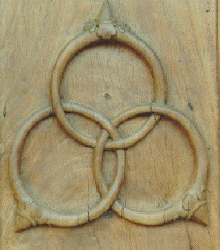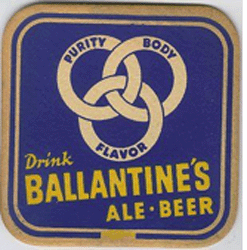Chem 220 - Organic
Chemistry
Problem Set 4
Chapter 5, Stereochemistry
Due: Monday, October
4, 2010

|
The
Borremean Rings
Versions of this symbol date to the time
of the Vikings.
In the 15th century, it was the symbol of a tripartite
alliance of the Milanese families Visconti, Sforza and
Borromeo via intermarriage. Break any (wedding?) ring and
the others separate, hence the alliance is broken. The rings
form a chiral
object (left) that is not
superimposable on its mirror
image. A set of Borremean rings
has been used as the logo for a certain refreshment that
extols purity, body, and flavor. Is the sense of chirality
of the two sets of Borremean rings the same or different?
For some other discourses on chirality, see:
Potpourri
The Figure 8
Knot
Gentlemen's
Neckties
Molecular
Knots
Snails and
Crabs
Snails, Snakes and Darwin (html) 1 2 (pdf) 1 2
|

|
Read the stereoisomers
module in the StudyAids and do the
exercises. There is no need to record answers on your
homework.
Don't forget the Chirality
of Shells (Powerpoint). Do
left-handed whelks have a better survival rate than their mirror
image brethren? Click here.
|
1. When
(R)-1-chloro-2-methylbutane undergoes free radical
chlorination, five dichloro constitutional isomers are
formed. What are these structures? Draw them. Be explicit as
to diastereomers, enantiomers, racemates, etc.
|
|
2. A 4:1 mixture of enantiomers has [α]D
= +120o. What is the rotation of the levorotatory
enantiomer? The dextrorotatory enantiomer? Show
work.
|
|
3. a) 1,2-Dibromoethane is optically
inactive yet it has a dipole moment. Explain and illustrate.
[Hint: Draw the staggered conformations and assess
optical activity and dipole moment for each.]
b) meso-2,3-Dibromobutane exists in three staggered
conformations, none of which has a plane
of symmetry. Yet the compound is
optically-inactive. Indeed, the only conformation that has a
plane of symmetry is quite unstable. Explain and
illustrate.
|
4. Which of the following compounds are, in
principle, capable of resolution? Explain and illustrate. [For a JSmol version of this problem. see Spring13, PS4, #4]

|
5. Terpenes are naturally occurring
compounds that are comprised of multiples of the
C5 unit isoprene (it looks like 2-methylbutane).
Limonene is a monoterpene that occurs as both enantiomers in
nature. The (R)-enantiomer has an orange, citrus-like
aroma while the (S)-enantiomer has a harsher, lemony
fragrance.
a) Of the limonenes shown on the right,
identify the R and S enantiomers.
b) (R)-Limonene (d-limonene) is reported
to have a rotation of [α]D
123.8o. Its enantiomer is reported as [α]D
101.3o. Assume that the enantiomer with the lower
rotation is contaminated with the other enantiomer,
calculate the percent of (+)- and (-)-enantiomers in the
sample.
c) When compounds containing double bonds
are treated with H2 in the presence of a noble
metal catalyst, hydrogen is added to the double bond. In the
case of (R)-limonene, two compounds, A and
B (both C10H20), are
formed. Are they necessarily formed in equal amounts?
Explain. Is the ratio A/B different when
(S)-limonene is used? Explain.
|

d) The energy difference between the
chair conformations of A is greater than the energy
difference of the chair conformations in B. What are
the structures of A and B? What are the energy
differences? Go here
for data.
|


